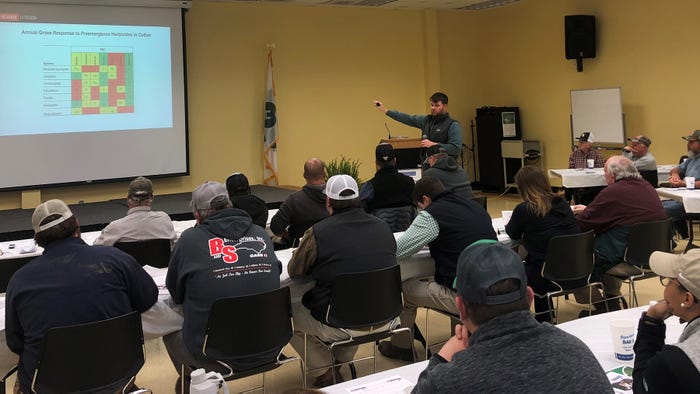
If you call Charlie Cahoon to ask him why you’re having such a tough time controlling such pesky grasses as Texas panicum, goosegrass, and broadleaf signalgrass in your cotton after spraying Roundup with dicamba or Roundup with 2,4-D, the first thing he will ask is what did you do behind the planter — not what postemergence herbicide you used.
“A lot of times, folks didn’t apply a PRE, or they applied a PRE that doesn’t have very good grass control,” Cahoon said at an Extension cotton meeting Feb. 15 at the East Carolina Agriculture and Education Center in Rocky Mount.
Cahoon, North Carolina State University Extension weed specialist for corn and cotton, emphasized that only two preemergence herbicides, Prowl and Warrant, offer good annual grass control in cotton across the board. “If you’re not using Prowl or Warrant as a part of your PRE program then you can’t expect to get excellent annual grass control.”
Cahoon said the right PRE is a must for effective grass control, as is remembering the cardinal rule of effective weed management: control grasses when they are small, before they become too tall. And indeed, start clean and stay clean.

At an Extension cotton meeting at the Eastern Agriculture and Education Center in Rocky Mount Feb. 15, North Carolina State University Extension Weed Specialist Charlie Cahoon stressed the importance of controlling weeds when they are small. (Photo by John Hart)
Complaints
Cahoon said complaints about grass control seem to follow trends in the use of glyphosate mixed with dicamba or 2,4-D in their post applications. He said farmers soon discovered that these combinations created some antagonism.
“This is a lesson we learned years and years ago, and we had to relearn it. The first mistake is no PRE with grass activity; the second thing working against us is we’re using Roundup in combination with these auxins. We know there’s antagonism there,” Cahoon said.
Research across the Southeast shows an average 10-15% decrease in grass control when adding dicamba to glyphosate, compared to glyphosate alone.
“That is easily overcome by increasing the Roundup rate if environmental conditions are ideal, grasses are small, and you don’t have a carpet of grass because you didn’t use a PRE,” Cahoon said.
Cahoon said it is critical that you use the approved nozzles on your sprayer if you are combining dicamba with glyphosate or 2,4-D with glyphosate. He said the approved nozzles produce big droplets which is great for reducing off-target movement, but the challenge is sacrificing some coverage, which may contribute to grass control issues. He adds that farmers can overcome less coverage with auxin nozzles by increasing their sprayer output.
“What really drives the bus when we get complaints are hot, dry drought conditions. When it’s hot and dry, those grasses are harder to control for several different reasons. You’re getting less herbicide in the plant, you’re moving less throughout the plant,” Cahoon said. “Under ideal conditions you may see 10 to 15 % antagonism but when you add hot, dry conditions, then antagonism may go up to 30 to 40%,” he said.
Cahoon acknowledges that North Carolina potentially has some glyphosate-resistant annual grasses which the weed science team is working to confirm, but he stressed the number of calls he receives from farmers complaining about troubles controlling these grasses with glyphosate mixed with either dicamba or 2,4-D goes well beyond herbicide resistance.
“If you are aware of all the factors contributing to reduced grass efficacy and control the factors in your control, hopefully you can limit any issues,” Cahoon said.
About the Author(s)
You May Also Like






